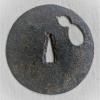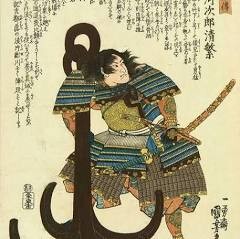-
Posts
6,438 -
Joined
-
Last visited
-
Days Won
23
Content Type
Profiles
Forums
Events
Store
Downloads
Gallery
Everything posted by ROKUJURO
-
YOSHITOSHI is wonderful!
-
We all make mistakes. Patience and persistance are the keys!
-
Jason, I don't think so. Would not be typical with flowers and flying insects. Rain is mostly not falling vertically in images.
-
Could be MYOCHIN NOBUIE. Perhaps also post in the TRANSLATION section.
-
This is basically correct, BUT the oxide layer on iron forms slowly in normal atmospheric condition. It is called "flash rust" when it gets more intense. It can be accelerated with higher temperature, so the above described colour changes can be seen when heat-treating carbon steel. In the West, these annealing colours are traditionally a guiding factor in tempering (= YAKIMODOSHI). As described above, the colours forming superficially are indeed super-thin layers of iron oxide, BUT they are not very stable and can be polished away. A straw colour would then correspond to an annealing temperature of about 200°C. In this case I don't see how such a colour would remain on a blade after the TOGI process, but a KANAHADA NUGUI (made with finest powdered magnetite (FeO x Fe2O3), suspended in oil), could darken the steel to an extent. If this magnetite is not pure and contains some hematite, the blade can even show a brownish hue. In the course of time, and with regular UCHIKO treatment, this colour will fade, resulting in a clean metallic surface. This is what I come up with when trying to explain the above described colour changes to myself.
-
Well Hector, as you are living near the "source" of all SAMURAI culture and weaponry, you will have good opportunities to study the subject extensively! I think it will be fun and a big advantage for you, compared with us other collectors who are not that lucky. All the best!
-
Hector, you are certainly right in that some people try to "age" IAITO TSUBA and sell them for a small profit. It was just your post where I could not see that evidence, the more as one grass in the "aged" TSUBA is even THICKER as in the left IAITO TSUBA. The SUKASHI (not tsukashi) could have been applied later, but I think all that messing is so much work that no one can make money with it in the end.
-
Nicholas, you probably meant CHOJI MIDARE. It is very difficult to show HADA in photos made at an angle. And if the polish does not expose the HADA very clearly (which usually needs high-end work), you will have problems to catch it in an image.
-
No, he did not mean that. The polish does not follow the HAMON, it is sloppy work.
-
Hector, I am sure this happens, but in this case, the TSUBA on the right is not made from exactly such a IAITO TSUBA. There are several small differences, easy to overlook.
-
If it has no papers it is likely GIMEI. There were more than 30 SUKESADA swordsmiths over the centuries, so you have to do your homework and compare the workmanship and signatures. It could be a legitimate BIZEN blade and GIMEI at the same time. Look at the quality and condition of the blade and not at the signature. You will probably not be able to find a genuine SUKESADA in decent condition for $ 3,000.--.
-
Marcin, that does not make the pictures any better. If we are requested to help, it is difficult enough with photos alone, so they should be as good as possible. It is useless to post bad photos, but it is not difficult to follow a few simple rules. Some dealers show bad photos to hide flaws, so they should be asked for better ones. Images posted here should be: - well focused, not foggy or blurry - made with a plain dark/black, non-reflective background for good contrast (not white, not patterned!) - made in a dark room, using spotlights - made with light from the side (may not apply to HAMON photos) - made directly from above (not at an angle) - made with correct orientation of the blade (straight vertically tip-upwards, especially NAKAGO photos) - without HABAKI, showing the MACHI and NAKAGO JIRI - made in high resolution to see details like BOSHI, HAMACHI, HAMON, HADA, NAKAGO JIRI etc. - presented as cut-outs so very little background is showing
-
Might that be ISE JINGU? (伊勢神宮)
-
Ryan, welcome to the NMB forum! If you look at your photos, you will see that they are slightly out of focus and show no details, so there is not much to report other than the HIRA-ZUKURI WAKIZASHI has relatively wide SUGUHA HAMON. From the accompanying text, it seems to be a KANEYASU sword.
-
My first impression was even plastic, but then I saw that an insert was glued into the hollow underside, so possibly bone. I don't see Schreger lines. In addition to that, I don't see HIMOTOSHI.
-
Sorry, I don't have books on swords to compare, that is something you will have to do now, perhaps online or with books. All online comments you will get from people on the authenticity on your blade are just opinions, based on photos. The only way to be more secure (never reaching 100,00%) would be a SHINSA panel in Japan. They can issue certification papers (= ORIGAMI) for blades and TOSOGU. And there is still another thing: A blade with a faked signature may still be genuine and nice to look at.
-
So you probably didn't see many. The MEI is chiselled in the NAKAGO on the outer side of the blade when worn. We call that side OMOTE. In rare cases (e.g. KATANA from HIZEN province), the signature is on the other side. We call that TACHI MEI because TACHI are worn cutting-edge downwards so the ura faces the outward side. So there is no right or left side of a blade but inner and outer side as worn by the SAMURAI.
-
Gary, weelcome to the NMB forum! There is not much you could do yourself to improve the condition of these swords except giving them a thin layer of low viscosity mineral oil AND wiping it mostly off so no oil gets into the SAYA (= scabbard). But luckily you have a real expert in Australia who you could ask for help: Andrew Ickeringill https://touken-togishi.com/ He will probably not work on these machine-made military blades but he could advise you what to do. In the meantime you could clean the red rust off the NAKAGO (= tang) just with a cotton rag, a soft brush, and A LITTLE oil. Nothing abrasive, so the patina is not damaged! This is normally not done on traditionally made Japanese sword blades, but in your case, it is all about preserving a piece of recent military history. Be patient as you clean, as damaging is easy! The MEI (= signatures) are nicely readable on two swords; they were probably made industrially in MINO province in the war.
-
....which will be the difficult part! Artur Oskroba has a wide range of TSUKA for sale, but fitting one to an existing NAKAGO is a lot of slow work!
-
I definitely think so. The TSUBA could have some age, maybe end of MUROMACHI or very early EDO, but unfortunately, corrosion is not a good indication of age.
-
Well, that is not a contradiction in my eyes. They just used a typical Western design for their anchor emblem. Traditional Japanese ones are not made that way.
-
Brad, to make it easier, better post this in the TRANSLATION section where the experts are. I think I can read TOMOTSUNE.






